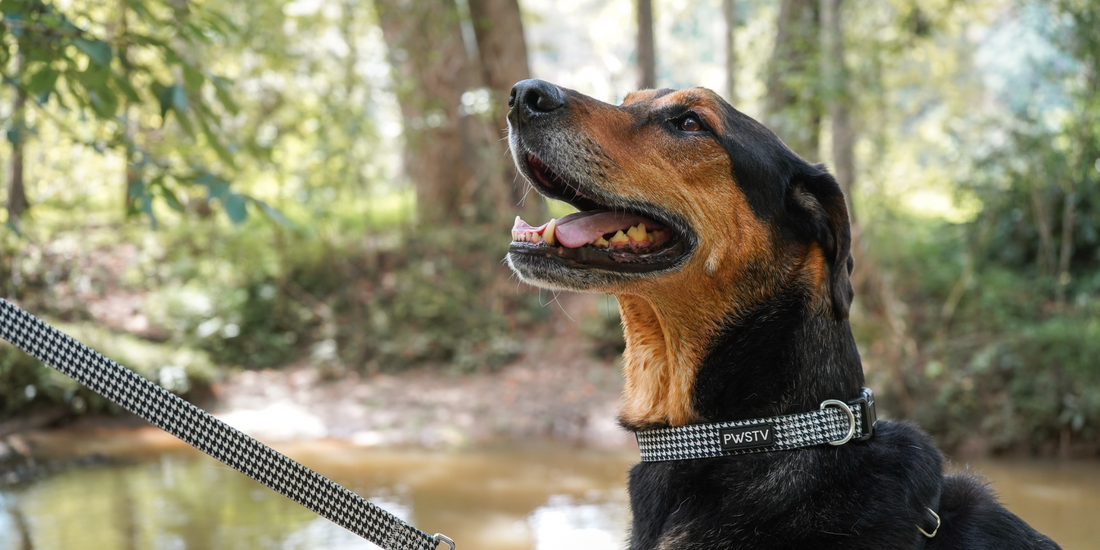Does your dog smile? Not every dog does - we have one smiley dog (Brody) and one not-so-smiley dog (Luna). A canine "smile" occurs when a dog holds their mouth open to some degree and pulls the corners of their lips up and back toward their ears, making it appear like they're smiling. But do dogs actually smile? If so, why? And What breeds smile most? Here are all your questions answered about dog smiles.
Do Dogs Smile?
Dogs sometimes look like they're smiling, particularly during the canine expression known as "relaxed open mouth." And with our tendency to anthropomorphize things (attribute human characteristics or behavior to an animal or object), we typically interpret these expressions as a smile. But scientifically speaking, it's extremely difficult to know if a dog is smiling, at least in the way we think of human smiles. This is because the tools used for researching dog expressions are mostly subjective. Some studies have found that the relaxed open mouth look often occurs when our dogs are in a positive state, but the reality is that there's little objective research about dog smiles.
That being said, it doesn't take science to know that dogs can appear to smile - dog owners experience it daily. But while it may look similar to a human smile, dog "smiles" are different. For humans, smiling is associated with happiness but for dogs, it can be a sign of both positive and negative emotions. It's a muscular reflex to something, typically related to the state our dogs in. For example, many dogs "smile" when relaxed and calm or after exercise when they're tired and trying to cool down. But they can also "smile" when feeling stressed or intimidated.
What Does A Dog Smile Look Like?
People often interpret a dog to be smiling when they exhibit the following behaviors:
- Open and wide mouth with lower jaw hanging down
- Lips pulled back and up toward ears
- Corners of mouth turned upward
- Panting
- Tongue hanging out or visible in the mouth
- Teeth showing
Why Do Dogs Appear To Smile?
There are many reasons why dogs "smile." Some of the most common include:
1. To express an emotional state.
Understanding the emotions of dogs is complex because we can't determine with complete certainty what our pets are feeling. The greatest difference between human and dog emotions is language - humans can use words to express their emotions. However, while we can't be told by our dogs exactly what they are feeling, we can use scientific research to help us understand how they work. For instance, MRIs have shown that dogs and humans have corresponding parts of their brains when responding to positive stimuli. In other words, dogs have emotional experiences. You may see your dog "smile" when they're:
- Relaxed and calm
- Happy (e.g. our dogs smile anytime we come home)
- Submissive (which can be misinterpreted for feeling guilty)
- Frightened, anxious or stressed
- Defensive or aggressive
2. As a response to human smiles and wanting to please their owners or people.
Dogs are skilled analyzers of human behavior and are also easily conditioned by positive reinforcement. Often times, humans react positively to a canine "smile," so our dogs learns to do it more. This is similar to the phenomenon known as laughter contagion. A smiling person may trigger a happy dog to smile and vice versa, especially since a smiling dog can release oxytocin in humans. While it may seem like our dog is mimicking our smile, in reality they are likely just learning that their smile makes us happy.
Pro Tip: One reason humans love when a dog appears to smile is because our body releases feel-good chemicals when we see someone or something smiling. These include endorphins and oxytocin (or the love hormone, which is responsible for emotional bonding). In fact, studies have shown that higher oxytocin levels help reduce stress (by lowering our cortisol (the stress hormone) levels) as well as boost our and our dogs' moods. Oxytocin has been show to help our physical, emotional and mental health by lowering blood pressure, improving healing processes and facilitating social bonding.
3. Neoteny
Neoteny is the retention of juvenile features in an adult animal, which occurred during domestication for canines. Adult dogs have retained several behaviors originally from puppyhood such as licking, nibbling, jumping, tail wagging, emotional greetings and "smiling."
Pro Tip: Dogs are so good at reading humans that most somehow understand the human smile where teeth are showing is not a form of aggression (unlike some other dogs), even with strangers.
4. Certain breeds
Some breeds are more prone to smiling facial expressions. For example, brachycephalic dogs look more smiley in general thanks to their flat faces and short noses. Also, dogs with thicker coats may appear to smile more from frequent panting to cool themselves down. Some breeds that tend to smile include, but are not limited to:
- Alaskan Malamutes
- Australian Shepherds
- Bichon Frises
- Boxers
- Cavalier King Charles Spaniels
- Chow Chows
- Dogue de Bordeaux
- Doodles
- English Bulldogs
- French Bulldogs
- Golden Retrievers
- Labrador Retrievers
- Pembroke Welsh Corgis
- Pit Bulls
- Pomeranians
- Poodles
- Pugs
- Samoyeds
- Shiba Inus
- Staffordshire Terriers
In General, How Can I Tell If My Dog Is Smiling Because They're Happy?
To know if your dog is smiling because they're in a positive state, you'll want to look at their body language. Some signs of happy or relaxed dogs include:
- Relaxed body and ears
- Wagging or neutral tail (where the tail sits naturally)
- Minimal to no face and mouth tension
- Calm look in their eyes
- Slightly open mouth
- Gentle panting
- Head tilt
- Drooling
- Reverted gaze
- Lip licking
In General, How Can I Tell If My Dog Is Smiling For Unhappy Reasons?
You'll also want to look at body language to know if your dog is smiling because they're anxious, frightened or showing aggression. Some signs include:
- Baring teeth
- Pinned ears
- Head pulled backwards
- Tense body and limbs
- Giving side-eye or wide eyes that show the whites, known as whale eye
- Lowered tail (sign of submission or anxiety)
- Raised tail (sign of dominance or aggression)
- Tucked tail (sign of fear or stress)
- Growling or snarling
The Main Types Of Dog Smiles
1. The Relaxed Grin
- Occurs when dogs are relaxed, calm and happy.
- Often seen when owners come home, when social dogs meet people, before and after exercise, etc.
- Signs include:
- Soft or squinted eyes
- Relaxed and loose lips
- Relaxed body and face
- Relaxed ears that sit naturally on head
- Relaxed muscles
- Neutral or wagging tail
- "Happy dance" (picking paws up and down quickly in a bouncing or dancing manner)
2. The Submissive Grin
- Occurs when dogs are trying to communicate submission to another as an appeasement gesture. This is not the same as an aggressive snarl but should be handled with caution as your dog is uncomfortable or intimidated.
- Often seen when dogs are uncomfortable, guilty, intimidated, fearful or generally shy and timid in personality. For example, when meeting a dominant dog, in a new situation or in trouble.
- Signs include:
- Lifted or retracted lips to show teeth (particularly in the front under the nose and exposing the front incisors)
- Flattened ears
- Lowered head
- Wide eyes
- Soft or tense body posture
- Squinty eyes, usually soft
Pro Tip: Did you know that scientists think the human smile originated as a sign of fear and submission? It's believed that the smile can be traced back more than 30 million years ago, when our closest biological relatives used it as a "fear grin." It's often observed in monkeys and apes to signal that they harmless to predators as well as pacification or appeasement to superior members of the species. Researchers believe that the human smile evolved from this.
In addition, smiling has been observed as a sign of nervousness and submission in wolves. So it's believed that dogs inherited that trait from their wolf descendants as a way to submit to superior pack members and accept their place in the rankings.
3. The Tense Grin Or Canine Grimace
- Occurs when dogs are stressed, uncomfortable or fearful but not threatening or defensive. Some excited dogs may exhibit it as well.
- Signs include:
- Corners of mouth retracted toward ears
- Lips pulled back and lengthened horizontally to expose teeth
- Pinned or pulled back ears
- Tense face muscles and jaw, especially around corners of the mouth
- Panting that is not happy but more stress-related
- Giving side-eye or wide eyes showing the whites (whale eyes)
- Head pulled back
- Tense and stiff body and limbs
- The appearance of a forced smile
4. The Closed Mouth, Restrained Or Strained Grin
- Occurs when dogs are stressed, anxious or uncomfortable, especially about something happening.
- Often seen in dogs who are sick or about to vomit.
- Signs include:
- Facial creases or lines from lips to eyes
- Pulled back lips with curled corners, resembling a forced closed smile
5. The Snarl
- Occurs when dogs are defensive or feel threatened.
- Often seen in dogs experiencing pain; trying to warn others to back off; asserting dominance over puppies, new family members or other dogs; those resource guarding or protective of food, toys, people, etc.
- Signs include:
- Lifted front lip to show front teeth
- Mouth pulled back and up
- Tense facial muscles
- Pinned or flattened ears
- Tense or stiff body and posture
Training Your Dog To Smile
You can train your dog to smile, which would mean that your dog isn't expressing any emotion but rather obeying a command. To do so, watch your dog carefully to learn when they "smile" naturally on their own. When you see them do so, reward immediately with a treat, praise, affection, attention or something else of value. Pick a cue to associate the behavior with, such as "smile" or "say cheese." You can also use a clicker, making sure to click quickly once your dog smiles then rewarding them. This type of training, where you reward your dog's behaviors that occur naturally, is called capturing.

